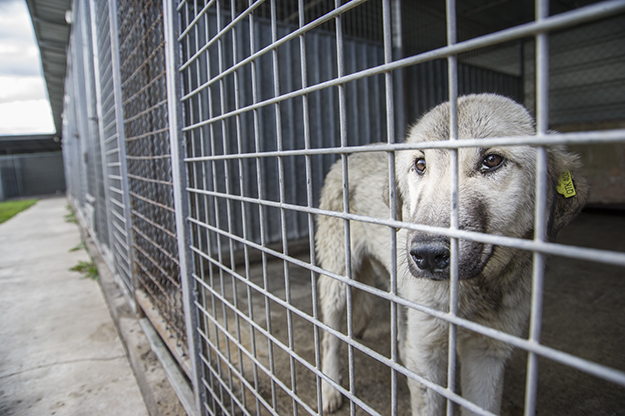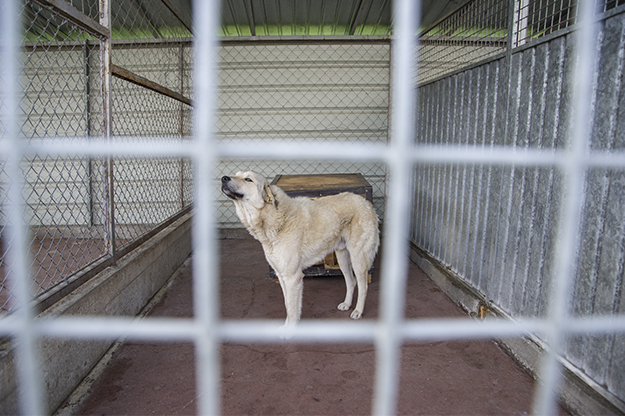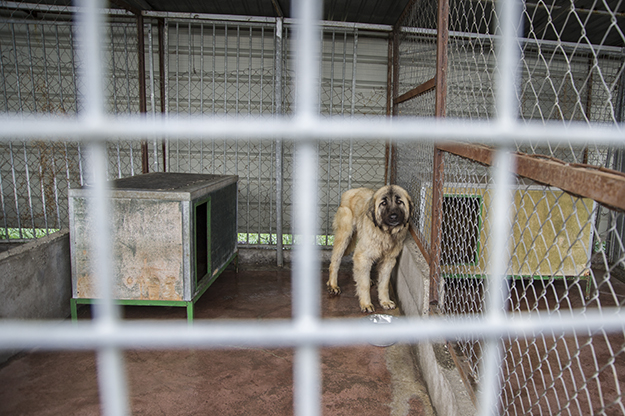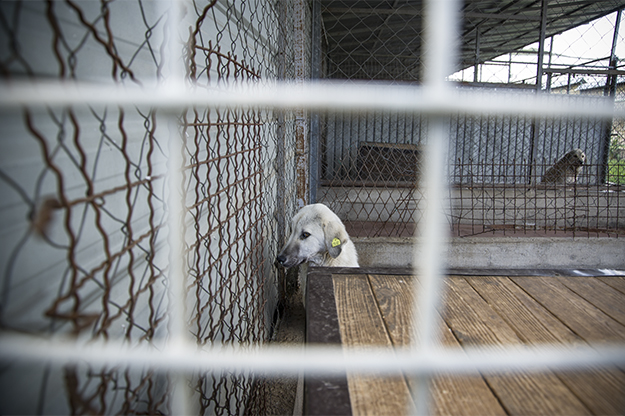Over the years, the typical state solution to issues caused by street dogs in Kosovo has tended to be simple: shooting, hunting and culling. It was thought that protests and alternative solutions involving vaccination and neutering had changed this practice, but an incident in Podujeva a few days ago has shown that Kosovo’s authorities are continuing to allow firearms to be used to cull street dogs.
On Tuesday (April 25), citizens of Podujeva reported that the streets of the city were filled with blood, after a hunting association called “Llapi” had gone on a shooting rampage “to control the dog threat.” Activists have reported that the hunters were accompanied by the Kosovo Police.
Subsequent reports have revealed that the Municipality of Podujeva had signed a contract with the company on April 4, this year. The contract is for “intervention on stray dogs in emergent cases” and is for the value of 7,467.20 euros. Although it is not mentioned in the contract, activists claim that the hunters are expected to kill at least 600 dogs for this money.
The Municipality of Podujeva has told Klan Kosova that the action was in accordance with the existing legal framework, as there are around 2,000 street dogs threatening the citizens and both the hunting association and the Municipality have stated that they are only killing dogs that pose a threat. However, a video recorded by local citizens claims to show puppies whose mother was shot while sleeping.
Solving the problem
Street dogs have been a perennially controversial topic. The death of a 5-year-old child caused by a pack of street dogs in December 2014 resulted in a media outcry, though certain animal rights activists (including Dafina Paca for K2.0) felt that media reports left out key details surrounding the incident.
Paca highlighted that both the child and the dogs were seeking food in rubbish bins, and the attack was a result of the dogs protecting their food source. As Paca said: “Both were engaged in instinctual behavior driven by hunger and suffering, and both had no voice.”
Regardless of opinions on this notorious incident, overall instances of attacks on humans have been low; that same year, according to police reports, there were just 10 incidents involving street dogs.
Opposition to shooting streets dogs has become more vocal in recent years, with animal rights activists stressing the cruelty and ineffectiveness of this method. They point out that the animals do not always die from the gunshots but suffer a slow and painful death through infection or blood loss, while the overall number of street dogs not seem to drop. The vacuum left after the culling presents an opportunity for dogs from other areas to fill the gap, and encourages further breeding due to more resources being available.
Catch, neuter, vaccinate, release
The alternative to shooting is the ‘CNVR method,’ an acronym that stands for catch, neuter, vaccinate, release. It is the method favored by StrayCoco, an international foundation that strives for street dog control through co-operation, and is active in countries with large street dog populations, including Kosovo.
On Dec. 7, 2016, the Kosovo Veterinarian Chamber, an independent association of veterinarians, made a statement, adding their support to CNVR being the best method to treat street dogs. Municipalities across Kosovo have begun to adopt the method, with it being utilized in Prishtina, Decan, Gjakova, Rahovec, Peja, Prizren, Gracanica and Malisheva to date.
Blendi Bejdoni is a veterinarian who, together with his wife, runs a veterinary clinic near Rahovec. Since registering in 2015, the clinic has treated around 4,000 dogs from across Kosovo with CNVR.
“The treatment begins with catching dogs in their habitats and transporting them to our clinic,” he explains. “We vaccinate them with the DHPPi vaccine and give them tablets against inner parasites. The next day, the dogs undergo a surgical procedure — either sterilized or castrated, depending on the gender — and at the same time we apply the vaccine against rabies and matriculation.”
The dogs are then kept under surveillance for the next three to five days, at which point they are released back into their natural habitat. Only in cases where the dogs are diseased or aggressive does the clinic apply euthanasia.
Bejdoni says that this is the only successful method for treating and reducing the number of dogs, and the same steps are applied across Europe.

New draft legislation proposes that dogs kept at shelters in Kosovo be euthanized after a 30-day period. Photo: Atdhe Mulla / K2.0.
However, the adoption of CNVR may soon take on a different form when implemented in Kosovo, with less attention paid to the final step in the method, ‘release.’ Recently, a draft-regulation has emerged, posited by a working group from the Food and Veterinary Agency of Kosovo (FVA). The draft regulation states that after animals are caught, vaccinated and neutered at shelters, if they are not subsequently adopted within 30 days, the should be be euthanized.
Animal rights NGOs have responded furiously to the draft, and found support in their protests from the Kosovo Veterinarian Chamber. The protesters have labelled the proposed regulations as both cruel and costly, since the same dogs that are caught, vaccinated and neutered, in the end get euthanized.
Allegations of profiteering have also been made. Shelters currently receive funding from the municipalities for each dog processed under CNVR; the Kosovar Center for Sheltering and Training of Street Dogs in Harilaq say that this figure starts from 30 euros per dog, depending on location. Adding a potential 25 extra days of shelter, food bills and then the cost of euthanasia on top under the proposed method, the money received by dog shelters would inevitably increase, to what activists estimate would perhaps be as much as 70 euros per dog.
The draft regulation is similar to existing legislation in the United States. But animal rights NGOs, who say that they were not consulted during the drafting process, have stated that Kosovo does not have the same culture of dog adoption that exists in the U.S., and that dog adoption is rare — a fact confirmed by dog shelters.
Dafina Paca agrees, and also points out that the 30-day waiting period in the U.S. is in order for the dog to be assessed by behaviorists, to establish whether its aggression is caused by fear or a result of human abuse, and to evaluate whether the dog can learn to trust again.
Paca is skeptical over whether this process will be applied in Kosovo and also believes that corruption is the motivation behind the new draft regulation. “Fundamentally this law is about making money for corrupt officials,” she says. “Because they are not experts and they lack knowledge in this area and they don’t want to learn because then they lose money.”

There is strong evidence to suggest that many dogs on Kosovo’s streets are domesticated animals thrown out by their owners. Photo: Atdhe Mulla / K2.0.
Domesticated dogs on the street
Helen Wormser, president of the Board of Trustees at StrayCoCo, does not believe that even well implemented CNVR can be successful by itself, unless some other issues are also addressed. She believes the root of the problem lies in the abandonment of domesticated dogs, left on the streets.
She points to the situation in Peja, where a CNVR program treated over 1,400 dogs. After the program was halted for six months, levels of street dogs returned to a similar number as before. This increase was clearly not the result of the existing street dogs breeding as most had been neutered.
Bejdoni says his clinic in Rahovec has treated 4,000 street dogs in just two years, whilst the Center in Harilaq also reports that it treats 700 dogs every six months. Judging by the number of public tenders for treatment alone, it appears that this widespread neutering has not resulted in a dramatic drop in the number of street dogs.
Wormser is clear on where she believes the dogs originate: “People, dog owners, dump them from everywhere, all over the municipalities.”
Dafina Paca adds that even a DNA test done in the UK on dogs that were adopted in Kosovo helps verify this claim, because none of the tested dogs was truly a feral dog. “Feral dogs that are in Africa are very different to the dogs in Kosovo,” she says. “The street dogs in Kosovo show us that they are breeds, mixed breeds. They also genetically have a pedigree breed, like doberman, golden retrievers, labradors, sharri dogs are very common.”
Paca argues that as Kosovo’s street dogs do not originate naturally but have been bred they are not adept at surviving in the wild. “If you look in Africa for example, the feral dogs have evolved, procreating without any owners,” she says. “Their size is very small, they have become similar, their features are similar. Whereas in Kosovo you have a mixture of breeds, different breeds that people have bought and have kicked out, because they were not prepared for what was involved or they were not neutering them.”
Legal protections
The dogs likely roots as domestic animals adds an interesting legal dynamic to the issue. The Law on Animal Welfare, dating back to 2001 states, in regard to the killing of animals, that: “except in cases of emergency which visibly indicate extreme pain which may be conducive to death, only a veterinarian or another competent person shall be permitted to kill an animal of a domesticated breed or any wild animal which has been domesticated.”
Many have taken the wording of this law to suggest that all culls of street dogs involving hunters and guns are illegal, in addition to the criticisms surrounding their costs, effectiveness and cruelty.

Draft amendments to the Law on Animal Welfare that aim to create more shelters have been stuck at the Assembly for some time. Photo: Atdhe Mulla / K2.0.
Implementation of the Law on Animal Welfare has often been weak. In 2014, animal rights NGO “Kosovo Dog Project 2014 (KDP14)” came up with a proposed solution, to strengthen both the existing legislation and its implementation, in draft amendments entitled: the Law amending and supplementing the Law on Animal Welfare.
The draft aims to appoint a special office under the Office of the Prime Minister, called the Dog and Cat Law Implementation Authority (DCLIA). Over a 2-year period, the DCLIA would be given the authority to dramatically reduce the number of street dogs by requiring minimum standards of behavior from dog and cat owners and the municipalities. The legislation outlines stringent requirements for pet owners as well as the registration of animals to owners.
Wormser believes that registration of dogs and and their owners would help reduce abandonment. “[StrayCoco] register the street dogs, but no one registers the owned dogs, and dog owners,” she points out, adding that a similar scheme in Switzerland helps create an environment with very few street dogs.
The amendments would also require the government to add to the existing number of shelters — with a minimum of 20 new sanctuaries and 60 new foster families — as well as building three more regional veterinary and outreach facilities.
The amendments have been completed and submitted to the Assembly of Kosovo and gained the support of 10,933 signatures from Kosovar citizens. However, no further action has been taken by the Assembly.
The leaders of the project, believe that if their recommendations were implemented, Kosovo would see a noticeable reduction in its abandoned dog and cat population within one year, and a dramatic reduction within four years. They say that it would also be economically efficient, effectively costing each citizen 0.60 euros per per year for the first three years, with that figure dropping to 0.50 euros subsequently.

The StrayCoco Foundation hopes that education can change public perception on street dogs, which includes their objection to keeping dogs in shelters. Photo: Atdhe Mulla / K2.0.
To find external examples of states successfully dealing with street dogs, Wormser suggests Kosovo looks to the Netherlands. In 1990 the World Health Organisation, together with World Society for the Protection of Animals, published a report on the most efficient method of managing street dogs. The recommendations suggested a combination of sterilisation (of at least 70 percent of female dogs), education (on being a responsible dog owner, controlling procreation, and avoiding abandoning) and registration (of both, the animals and the owner). The Netherlands adopted this method, and nowadays has next to no street dogs.
In this vein, the StrayCoco Foundation has also begun working on education to help change perspectives on street dogs in an attempt to move beyond the prevailing narrative of seeing the animals as a menace and a pest.
In some large cities around the world the presence of street dogs has inspired literature and attracted tourism, such as in Moscow, where a bronze statue has even been erected of a street dog killed in a train station. Even if such a step may seem a little far-fetched in Kosovo, activists hope that a change in attitudes can help every dog, one day, have its day.K
This article is a response to reader questions during our #IWantToKnow campaign on animal welfare issues. The #IWantToKnow campaign has been supported by the Embassy of the Netherlands in Kosovo.
*Editor’s note: One image in this article has been removed as the caption mistakenly referenced that it featured Blendi Bejdoni.
Feature image: Atdhe Mulla / K2.0.


My daughter and her son have been desperately upset at the plight of the street dogs in Peja, particularly one who is quite badly injured. They are in Peja for a tennis tournament and tried to contact the local Pishrina shelter, who are sympathetic but say they do not have funding to come and help it. Anything you can do to help would be most welcome. This awful situation should be publicised more. Could our British RSPCA not help out, or other richer countries? Thank you. I want to help but have not got a lot of money and don’t know how to help.